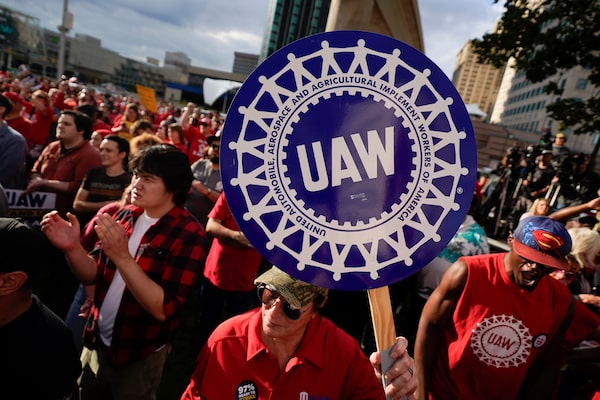
United Auto Workers members attend a rally in Detroit, Friday, Sept. 15, 2023.Paul Sancya/The Associated Press
Talks between the United Auto Workers and the Detroit Three auto makers resumed on Saturday, a day after the union initiated the most ambitious U.S. industrial labour action in decades with simultaneous strikes targeting a trio of auto plants.
The four-year labour deal between the union and General Motors, Ford Motor and Chrysler-parent Stellantis expired at 11:59 p.m. EDT on Thursday. Stellantis said on Saturday it has hiked its offer, proposing raises of 20% over a four-and-a-half-year contract term, including an immediate 10% hike. That matches proposals from GM and Ford.
The auto makers say the proposals work out to a cumulative 21% hike over the period, but they are still significantly below the 40% wage hike the UAW is demanding through 2027. The union’s wage demand includes a 20% immediate increase.
“We do care. We absolutely do care,” Mark Stewart, the North American chief operating officer for Stellantis, told reporters on Saturday, describing the company’s latest offer as “very compelling.”
“This is not about greed. This is about sharing success,” he said.
Stellantis also said it is offering more than $1 billion in retirement security improvements and other increases in benefits. Stewart said the UAW rejected a Stellantis proposal to keep an Illinois assembly plant open that was contingent on reaching agreement before the contract expiration. He declined to offer specific details, but added that the company was still willing to talk about the facility’s future.
‘GO THE DISTANCE’
The strikes have halted production at three plants in Michigan, Ohio and Missouri that produce the Ford Bronco, Jeep Wrangler and Chevrolet Colorado, along with other popular models.
Auto makers say they need cost-competitive contracts because of the need to spend billions of dollars to make the transition to electric vehicles (EV), while workers note U.S. auto makers have enjoyed robust profits over the last decade and had hiked CEO salaries by 40% on average since 2019.
On Friday, Ford said it was indefinitely laying off 600 workers at a Michigan plant because of the impact of the strike at the facility, which makes the Bronco SUV, and GM told some 2,000 workers at a Kansas car plant that their factory likely would be shut down next week for lack of parts, stemming from a strike at a Missouri plant.
Stellantis said on Saturday it does not anticipate any other plants being disrupted by the strike at its Jeep plant in Toledo, Ohio.
UAW President Shawn Fain called the reports of planned layoffs of nonstriking workers an attempt by the auto makers to “squeeze” union members into accepting a weaker settlement.
“Their plan won’t work,” Fain said in a statement. “We’ll organize one day longer than they can, and go the distance to win economic and social justice at the Big Three.”
Besides higher wages, the UAW is demanding shorter work weeks, restoration of defined benefit pensions and stronger job security as auto makers make the EV shift. The union also wants an end to so-called “two-tier” wages, while auto makers have proposed cutting the number of years needed to reach top pay levels from eight to four years. The UAW said the auto makers has rejected many key demands.
U.S. auto makers have said the UAW demands could hike the current mid-$60-per-hour labour cost to more than $150 an hour. GM said on Thursday the UAW wage and benefits proposals would cost it $100 billion, while Ford CEO Jim Farley said the 40% UAW wage hike would “put us out of business.”
U.S. President Joe Biden, who faces re-election next year, called on Friday for the auto companies to reward workers just as executives’ salaries have risen. “The companies have made some significant offers, but I believe they should go further to ensure record corporate profits mean record contracts,” he said.